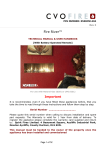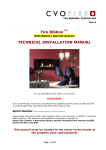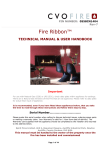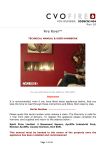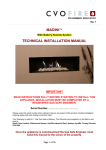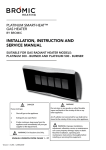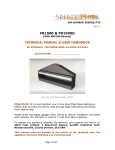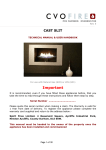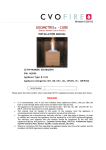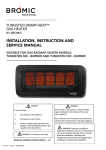Download Black Box AC096A Technical data
Transcript
PIN NUMBER: 0558CN1404 Rev 1 Fire Break [With ACS2 Remote System] TECHNICAL MANUAL For use with Natural Gas (G20) or LPG (G31) Important It is recommended, even if you have fitted these appliances before, that you take the time to read through these instructions and follow them step by step. Serial Number ……………………………… Please quote this serial number when making a claim. The Warranty is valid for 1 Year from date of delivery. To register the appliance please complete the warranty card supplied and return to the address below: Spirit Fires Limited. 4 Beaumont Square, Aycliffe Industrial Park, Newton Aycliffe, County Durham, DL5 6XN. This manual must be handed to the owner of the property once the appliance has been installed and commissioned. Page 2 of 56 Contents Page Page Page Page Page Page Page Page Page Page Page Page Page Page Page Page Page Page Page Page Page Page Page Page Page Page Page 3 4 6 7 8 9 10 11 12 13 14 26 27 29 30 31 31 32 33 34 35 35 37 38 38 39 41 Commissioning Results & Checklist Technical Data Introduction Unpacking the Appliance General Installation Instructions Mains Electrical Power Supply Gas Supply Enclosure Construction & Parts Enclosure Part Identification Burner Construction Installation Instructions Positioning the Magic Eye Commissioning the Fire Technical Help Fault Diagnosis Oxygen Depletion Pilot System Burner Flame Warning Fire Guards and Hearths Fault Diagnosis Table Remote Control Components Battery Remote System Service and Aftercare Servicing Instructions Exchangeable Components List Fitting Spare Parts Burner Removal Fault Diagnosis/Troubleshooting Gas Fire User Instructions Page 3 of 56 Commissioning Checklist & Results To validate the Warranty and to help with Technical Issues all sections of the Commissioning Sheet must be completed and readings recorded. The complete fireplace must be installed by a Gas safe Engineer. Installer Name………………………………………………………………… Installer Company…………………………………………………………… Gas Safe Registration Number…………………………………………… Commissioning Date…………………………………………………………… Item Description Readings/Result Pass/Fail 1 Appliance Enclosure Fitted and sealed inline with Instructions? 2 Burner Ventilation Provided? 3 Room Ventilation Provided? 4 Gas Pipe Work Compatible with Appliance Gas Consumption Requirements? GAS PRESSURE TESTS [Using Test Point within the Appliance Only] Stage 1 - With Other Gas Appliances in the home OFF 5 Gas Standing Pressure. [Fire Off] 6 Gas Pressure [Fire On Pilot] 7 Gas Pressure [Fire On Full] Stage 2 - With Other Gas Appliances in the home ON 8 Gas Standing Pressure. [Fire Off] 9 Gas Pressure [Fire On Pilot] 10 Gas Pressure [Fire On Full] WARNING: If the Appliance fails any of the above tests it must not be used until the problem with the Gas Pipe Work or Gas Meter have been rectified. CHIMNEY/FLUE TESTS 11 Flue System Diameter and Length complies with minimum allowed? 12 Appliance Gather Used? 13 Spillage Test Performed? 14 Flue System Flow Test Performed? When calling our Technical Team for help or advice please have the above data available. Page 4 of 56 Page 5 of 56 Dimensions The fire is supplied with a firebox including gather unit. When constructing the builders opening an allowance must be made for both gas and electrical connections and adjustments. Page 6 of 56 Introduction TO AVOID COSTLY INSTALLATION MISTAKES PLEASE READ THESE INSTRUCTIONS BEFORE STARTING TO INSTALL THE APPLIANCE. THE MOST COMMON FAULTS CAUSED DURING INSTALLATION ARE INCORRECT GAS PRESSURE AND INCORRECT WIRING OF THE MANUAL WALL SWITCH. Important Note: Every FIREBREAK is fully built onsite at the CVO factory prior to being shipped to ensure that all parts fit together correctly. The burner is given a total of 44 performance checks to ensure it operates correctly and inline with CE approval. Claims will not be accepted for damage to the fire during installation. Important Note: This is a high power appliance and a steady gas supply within +/- 1mBar of the approved pressure as shown on the data plate must be maintained at all times. Note: Before starting to install the appliance ensure the pipe work is suitable to supply a steady gas supply as indicated in the “Gas Consumption” section of the Technical Data. Gas inlet is via an 8mm gas line. If the gas line is longer than 1.5mtrs then the gas line should be increased in diameter to 15mm and possibly larger depending on the length of gas pipe required. Natural Gas 1.4 m3/Hour LPG/Propane 0.8 m3/Hour Important Note: A gather is supplied as standard with this appliance and it must be used. To ensure the flame quality and debris does not enter the enclosure. It is also required to seal the enclosure to a flue liner [if used]. This appliance is supplied as a complete fireplace suite of enclosure of gas fire burner unit, enclosure with V-Groove shelf. To comply with the approval this fire must be installed as designed. As this is a large fireplace with heavy stone parts it will require at least 2 engineers to fit the fireplace. The Complete assembly of this fireplace suite should be carried out by a trained Gas Engineer who accepts all responsibility for the complete installation including the flue system, the enclosure, gas pipe work, gas connections and electrical connections. To validate the warranty CVO Fire will request the details of the Engineer who has taken responsibility for the complete installation and the commissioning results as shown on Page 3. The enclosure must be installed as intended and ventilation to the burner unit must be provided. This appliance requires a 240v 3A fused spur next to the appliance and within easy access of the user. Page 7 of 56 Unpacking the Appliance Read these instructions fully before proceeding. • Parts o o o o o o o Supplied: Black Steel Enclosure Black Steel Gather Gas Burner with Remote Control [Pre-Fitted to Enclosure] Installation Kit with Installation Booklet. Remote Hand Set Stone Sections : 13 Pieces in Total Mains Power Adaptor The FIREBREAK involves a large number of heavy stone parts which must be handled with great care. Carefully examine the carton for damage before unpacking. If it is obviously damaged, consult the supplier over whether to proceed. Remove the fire and examine its general condition. Any damage or defects must be reported “before” installing the appliance. No claims will be accepted for damage after the appliance has been installed. The complete installation of this appliance should only be carried out by a GAS SAFE Registered fitter and in accordance with national and local Regulations for both gas, electricity and building control. Failure to have the fire fitted by a qualified person nullifies ALL guarantees. For the Republic of Ireland, reference should be made to IS813 and ICP3 and any guidance notes from Bord Gais. NOTE: Great care should be taken when handling the stone as it can be easily damaged. If satisfied by the condition proceed with the installation. Planning the Installation 1. Before starting to install this fire note that it requires: a. A 240v Mains Supply b. A Compatible Flue System (See Technical Data) c. Room Air Ventilation of minimum 100cm2 d. A Strong Gas Supply (See Gas Supply) e. Complete Installation by a Qualified Gas Safe Engineer. Page 8 of 56 General Installation Instructions This fire is intended for decorative purposes. The installation must be in accordance with National Regulations and all parts of the installation must be carried out by a qualified GAS SAFE installer. Prior to installation, ensure that the local distribution conditions (identification of the type of gas and pressure and the adjustment of the appliance) are compatible. The builders opening or fireplace opening must be constructed of a noncombustible material. Clearances between the fire and all combustible materials must conform to National Regulations. This fire must be installed and used in accordance with these instructions. For some countries a non-combustible hearth must be fitted in front of the fire in accordance with National Regulations (e.g. United Kingdom). The chimney must be swept before the appliance is installed. NOTE: If the chimney is not swept, there is a possibility that loose debris will fall onto the appliance which may result in damage and unnecessary service costs. Before the fire is installed a flue test in accordance with National Regulations should be carried out. The unit must not be installed unless the chimney / flue length is at least the length and size indicated in 19.1 ‘Technical Data’. Under no circumstances should this unit be installed and operated within any premises without an adequate flue or chimney system. Any flue damper plate or flue restrictor must be removed or fixed permanently in the fully open position, or shall only be fitted in accordance with National Regulations. The gas connections must be in accordance with National Regulations. An isolation valve, or valves, has to be fitted adjacent to the appliance which, when closed, allow(s) the complete burner and control assembly to be disconnected for maintenance or repair in accordance with National Regulations. The pilot light and flame sensing device fitted to this fire is also an atmosphere sensing devise. If for any reason any part of the pilot assembly is to be replaced ALL the assembly including the pilot burner, thermocouple, electrode and injector must be exchanged complete for an original manufacturer’s pilot assembly only. This atmosphere sensing devise is not adjustable and must not be put out of action. The pilot light shuts off both the main burner and pilot if evacuation of the combustion products is interrupted. If the fire shuts itself off, do not use the fire, and have the flue and fire checked by a suitably qualified person. The correct method for re-lighting is shown in ‘Re-setting the ApplianceThis appliance requires Outside Air Ventilation. Purpose provided air supply must be fitted in accordance with National Regulations (e.g. United Kingdom minimum 100 cm2) Page 9 of 56 Mains Electrical Power Supply The fire is supplied with a 240V mains adaptor which must be connected to a 3A fused power outlet. The mains adaptor is connect to the fire via a power socket on the remote housing. WARNING: Care must be taken to ensure the power cable is routed away from any hot surfaces. Page 10 of 56 Gas Supply • • • • • • • • This is a high power appliance which requires a strong and steady gas supply to avoid the safety device shutting the appliance down. The gas pressure must be maintained at +/- 1mBar of the approved pressure as shown on the data plate at all times – this requires testing the appliance with the other gas appliance in the home both switched on and switched off. Do not start installing the appliance until the pipe work has been checked. Before starting to install the appliance ensure the pipe work is suitable to supply a steady gas supply as indicated in the “Gas Consumption” section of the Technical Data. o Natural Gas 1.4 m3/Hour o LPG/Propane 0.8 m3/Hour Gas inlet is via an 8mm gas line. If the gas line is longer than 1.5mtrs then the gas line should be increased in diameter to 15mm and possibly larger depending on the length of gas pipe required. There are gas inlet points on the sides and the back. Any unused inlet points should be sealed to ensure there is no adverse draw or flame reversal when the burner is lit. LPG Version. o If running this appliance from Gas Bottles two 47Kg bottles with a regulator and changeover valve will be required. This will ensure a steady supply in all weather conditions. o Bottles must be stored outside and fitted by a qualified Calor Engineer inline with current regulations. o Failure to do this will result in nuisance shutdowns. ALL GAS PRESSURE TESTS ON THIS APPLIANCE MUST BE CARRIED OUT USING THE TEST POINT WITHIN THE APPLIANCE. Page 11 of 56 Enclosure Construction & Parts Page 12 of 56 Enclosure Part Identification Page 13 of 56 Bronze Version This is the same size as the Stone Version with only minor differences. If in doubt about assembling the Bronze version please call 01325-327221. Burner Construction Every CVO Fire is tested for 1 hour at the factory. This includes 44 individual function checks. This ensures the appliance is supplied in a fully working condition. Take some time to review the burner construction taking note of the positions of the main components and connections. • Three Connections are required: o Mains 240v Supply via 3A fused spur o Gas Connection via 8mm Isolation Valve. WARNING: Removal of the connections from the remote system or the grommets marked “Electric Supply” or “Hard Wire switch lead” as shown in the burner construction drawings will result in the warranty being invalidated. No claims will be accepted for damage caused by the burner being tampered with. DO NOT REMOVE THE HEAT SHIELD DO NOT CHANGE THE BURNER AERATION. DO NOT CHANGE THE BURNER PIPE WORK Page 14 of 56 Installation Instructions A qualified person should complete all building work; a qualified and competent person to all relevant national legislative controls must carry out the installation of gas burners, mechanical extraction, flue systems and remote control units. Final responsibility for the complete installation is with the Gas Safe Engineer who connects this appliance to the gas supply. Building work Building work should only commence after a thorough survey of the intended location of installation has been completed and it has been established that the unit can be installed and operated without risk to the owner or tenants of the property or their neighbours. Where existing chimney systems are to be used in conjunction with the appliance, they should have been swept and undergone thorough examination to ensure that they are in a sound and safe condition, as well as providing an adequate draw when the gas fire unit is in operation. [See Technical Section] A simple smoke test will reveal whether or not the chimney is working correctly. Installation Procedure It is important that the gas supply is disconnected before any existing surround and hearth is removed. The original fire opening must be closed, using bricks / blocks. In fill any void below the fire to ensure a solid base is available to mount the enclosure. Allow 15mm clearance in the height of the fire opening for adjustments. In some installations it is necessary to install a small lintel unit above the opening. If so, an allowance must be made to accommodate the lintel. NOTE The FIREBREAK does not have its own support lintel. The FIREBREAK enclosure should be located centrally to the existing flue / chimney at your desired height. Ensure the gas supply is to the required standard [pipe work size is critical on this appliance] and electrical connections are in place (READ EARLIER SECTIONS). Any unused access holes must be sealed with suitable metal tape. This ensures that air cannot be drawn into the chimney from the lower half of the appliance. If not done there will be adverse air travel and flame reversal will occur when the appliance is lit. Page 15 of 56 The gather supplied with the fireplace must be used. This can be inserted into the fireplace opening and then lowered onto the enclosure before being sealed in place with silicone fire cement. The enclosure should be fitted within the opening with the front edge “flush” with the final finished wall. The enclosure once in place, should be drilled and secured to the fireplace opening using plugs and screws. This should be done taking great not to damage the burner or remote system. The enclosure must be sealed to the finished wall and rendered etc ready for the final assembly of stone enclosure. The Stone. There are 13 pieces of stone supplied. The fireplace has been fully assembled at the factory before being dismantled and packed. This ensures that all pieces fit correctly. Check the stone drawing on page 12 to identify each piece. Check the stone assembly drawing on page 11 to see where the pieces fit. See Attached Installation Images of gather and stone assembly: Page 16 of 56 IMAGE #1 The gather must be used in all installations. The gather mounts directly on top of the enclosure. It is possible to insert the gather into the fireplace opening first then slide in the enclosure and lower the gather on to the enclosure. This allows for a smaller construction opening. ITEMS N – M – O These form the back sections. Very carefully lift over the burner and lock into the top slot. Fit item N and O first then fit M last and slide them together to form a complete back. The stone is fitted loose to allow it to expand. Page 17 of 56 IMAGE 2 & 3 Once in place the gather must be secured with the screws provided. Then sealed with a high temperature silicone fire cement. At this stage the electrical mains connections, manual wall switch and the gas supply connected ready for testing and commissioning. Page 18 of 56 IMAGE 4 & 5 ITEMS N – M – O These form the back sections. Very carefully lift over the burner and lock into the top slot. Fit item N and O first then fit M last and slide them together to form a complete back. The stone is fitted loose to allow it to expand. ITEM A – B These are the side pieces. Apply a small amount of Fire Cement to the sides of the black enclosure. Ensure that no cement touches the stone. Carefully slide in the side pieces of stone. Page 19 of 56 IMAGE 6 & 7 ITEM C Carefully insert the rear shelf ensuring the sloping part is facing forward. Ensure that the pilot assembly on the burner is not disturbed. Page 20 of 56 IMAGE 8 & 9 ITEMS D & E Carefully insert the small in fill stone sections on both sides. Page 21 of 56 IMAGE 10 & 11 ITEM F Fitting the Shelf requires two people. Take care not to chip the stone on the sides. [Especially the limestone version which is very soft] Page 22 of 56 IMAGE 12 The front shelf locates under the two clips inside the enclosure this ensures the shelf is in the correct position for fire operation and the shelf cannot move. IMAGE 13, 14 & 15 – Fitting the Stone Trim The stone facia can now be fitted providing the wall surface is perfectly level both vertically and horizontally. Important: If the wall is not level, it should be skimmed until level. Fractures in the facia / surround can occur if fitted to a wall with an uneven surface. See image below. Page 23 of 56 WARNING: The stone trim is supplied in 6 pieces. Take time to review the polished sides and unpolished sides. The unpolished side must be bonded to the wall. To bond the stone use high temperature silicone fire cement or a high temperature instant grab adhesive. UPPER TRIM The upper trim must be fitted to allow the stone shelf to be removed when the fire needs to be commissioned and also for servicing. To do this a small gap of 2mm gap is required under the side trims before they are bonded to the wall. This can be achieved by using a small piece of cardboard or plastic which can be removed when the glue is dry. [see image] Page 24 of 56 ITEMS L – J – K Use Fire Cement on the sides and along the top to bond the stone to the wall. The stone should be central and spaced equally on both sides. Take note of the comments on the previous page regarding spacing the lower pieces [see image on page 23]. LOWER TRIM. ITEMS G – H - I Using Silicone Fire Cement bond the two smaller sections to the wall ensuring they are inline with the upper trim. Take part G and bond this to the three lower struts ensuring it is in line with the rear trim pieces. This will need fixing with metal tape or another suitable method to ensure it stays fixed until the glue dries. See image on page 25. Note: the lower section must be left open as it provides burner ventilation. Page 25 of 56 IMAGE 16 This is the final finished assembly with the stone in place. WARNING – FRONT STONE This is a “Floating Hearth” to protect the user from the flame. It must not be leant on or heavy items placed on it. Failure to observe this will result in the stone being damaged. Page 26 of 56 Positioning the Magic Eye The Magic eye is supplied within the burner housing. Great care should be taken when handling this component. The eye should be positioned on the wall under the lower stone pieces with the curved/domed face forward. There must be direct “line of sight” between the hand set and the magic eye to ensure the hand set works correctly and efficiently. Once the fire is fully installed it is ready to be commissioned, this must be done by a GAS SAFE ENGINEER who will take full responsibility for the final installation. Read the section later in this manual “Lighting the Fire” to familiarise yourself with this procedure. Page 27 of 56 Commissioning the Fire Use the sheet on Page 3 to record the results of the commissioning procedure. This will allow the CVO technical team to resolve any installation issues that arise. Before starting the fire check it complies with the instructions detailed earlier in this manual. Check the Data Plate to review the required gas type and pressure. Light the appliance to allow air to be purged from the system. This may take a long time depending on the pipe work. Once the pilot lights switch off the appliance ready for commissioning as detailed below. RECORD RESULTS IN COMISSIONING SHEET ON PAGE 3 1. 2. 3. 4. Is the appliance sealed to the chimney and room? Is the burner ventilation gap under the shelf free from obstruction? Is there a minimum of 100cm2 purpose provided room ventilation? Is the pipe work fitted suitable for the appliance and inline with the gas consumption of the appliance? TEST THE GAS PRESSURE Carefully remove the front shelf and connect a manometer to the test point within the appliance. See image below. Page 28 of 56 WARNING: At all times the gas pressure must be within +/- 1 mBar of the rated stated on the data plate. For example a G20-20mBar Natural Gas Appliance must be 19mBar to 21mBar. Failure to observe this will render the appliance unreliable and possibly dangerous. 5. Ensure all other gas appliances in the home are switched off. With the appliance switched off test the inlet pressure. Does it comply with the above instructions? Write down the result in the commissioning sheet. Test the inlet line for soundness to ensure there are no leaks in the inlet gas pipe work. 6. Light the appliance. There is a 10 second period where the pilot will spark. It may light and continue to spark – this is normal. Once the pilot is lit note the pressure reading on the manometer. a. Does it comply with the above instructions? b. Write down the result in the commissioning sheet. 7. Once the main burner lights let it run on full for 5 minutes then while lit note the pressure reading on the manometer. a. Does it comply with the above instructions? b. Write down the result in the commissioning sheet. 8. Turn off the appliance and light all the other gas appliances in the home. Check the inlet pressure. a. Does it comply with the above instructions? b. Write down the result in the commissioning sheet. 9. Now light the fire again. Once the pilot lights note the manometer reading. a. Does it comply with the above instructions? b. Write down the result in the commissioning sheet. 10. Once the main burner lights let it run for 5 minutes then while lit note the pressure reading on the manometer. a. Does it comply with the above instructions? b. Write down the result in the commissioning sheet. IF ABOVE TESTS ARE FAILED : DISCONNECT THE APPLIANCE AND DO NOT USE IT UNTIL THE INLET PIPE WORK IS IMPROVED OR THE REGULATOR ON THE GAS METER IS ADJUSTED. IF ABOVE TESTS ARE PASSED : Continue with the commissioning. 11. The installer must check that all of the combustion products are entering the flue after 10 minutes by traversing the perimeter of the fireplace using a smoke match. 12. The installer must brief the customer on the operation of the appliance and give them the instructions. The customer must be told of the need for regular servicing of the appliance, this will be at least once a year, and be made aware that no rubbish is to be thrown onto the fire bed. 13. The customer must also be aware that purpose provided ventilation should be checked regularly. Page 29 of 56 TECHNICAL HELP SECTIONS Fault Diagnosis/Troubleshooting Every CVO fire is tested in the factory and give a 40 point check to ensure it operates correctly. It is highly unlikely it would not operate when installed as designed. The biggest cause of installation problems with this fire are caused by incorrect GAS PRESSURE. This is normally due to ignoring the instructions in the section “READ THIS FIRST” where is clearly states to check the gas pipe work before installing the fire. This is a 12kw appliance and needs a very strong gas supply that is maintained at within 1mBar of the appliance setting. NATURAL GAS = 19mBar to 21mBar. LPG = 36mBar to 38mBar. If the commissioning procedure is not followed and the fire is left to run with the wrong gas pressure the fire will: 1. 2. 3. 4. 5. 6. Fail to light. Light for a few seconds. Shut down unexpectedly. Have a low flame. Have a yellow flame. Cause sooting in the enclosure. Other areas to check during installation are: 1. 2. 3. 4. Has the pilot been knocked and the gap too large? Are the batteries fitted properly? Is the magic eye positioned correctly? Is the flue operating correctly without reverse drafts or air leaks? Common Faults • • • • • • • • • Spark Gap incorrect [see manual] No Power or fuse blown [see manual] Gas Pressure too high or too low causing sudden appliance shutdown or incorrect flame pattern. Low gas pressure causing a long or repeated ignition period before the fire will light. Gas leak in the inlet pipe work causing a long or repeated ignition period before the fire will light. This is due to the gas in the pipe work being replaced by air. No Room Ventilation being provided. Incorrect Flue System causing sudden shutdown of the appliance. Not following the lighting procedure [read lighting section] Not using the hand set properly [read lighting section] Incorrect wiring of the manual wall switch [see manual] Page 30 of 56 Oxygen Depletion Pilot System The pilot light and flame sensing device fitted to this fire is also an atmosphere sensing device. If for any reason any part of the pilot assembly is to be replaced ALL the assembly including the pilot burner, thermocouple, and electrode must be exchanged complete for an original manufacturer's pilot assembly only. This atmosphere sensing device is not adjustable and must not be put out of action. The pilot light shuts off both the main burner and pilot if evacuation of the combustion products is interrupted. If the fire shuts itself off, do not use the fire, and have the flue and fire checked by a suitably qualified person. Spark Failure For the fire to operate consistently the gap on the pilot assembly is critical. See image above. Page 31 of 56 Burner Flame The flame on this type of appliance is normally directed towards the rear of the enclosure. This is normal due to the opening size and flue system. The flame will never stand “upright”. It is to be expected that over time the surface on the rear of the enclosure will tarnish. This is typical “wear and tear” for a gas fire. If the flame is drawn under the shelf this highlights a serious installation fault and the appliance must not be operated until the cause is found. A typical cause would be unsealed burner holes or failure to seal the enclosure and flue (flame reversal). Any resulting damage is not covered by the warranty which covers “defective” parts only. Warning: Fire Guards & Hearths This appliance is not fitted with an integral guard. In normal use consideration may be given to the use of a fireguard conforming to BS6539 or BS6778, so that the approach to the appliance is limited such that access to the flame is minimised It is recommended that a fireguard conforming to BS6539 or BS6778 is used for the protection of young children, the elderly and infirm. The installer is to advise the user not to stand too close to the appliance for prolonged periods of time and warn that loose clothing is particularly at risk of burning due to the presence of an unguarded flame. In addition, the installer is to advise the user against placing combustible material directly in front of the appliance. Floor coverings, such as carpets, are considered to be acceptable. For some countries a non-combustible hearth must be fitted in front of the fire in accordance with National Regulations (e.g. United Kingdom). Page 32 of 56 Quick Reference Fault Diagnosis Symptom Check List The system “beeps” all the time. There is a fault diagnosis system built into the battery remote. The remote gives out a sequence of “beeps”. This is a code which indicates a fault. See page 38 for details. Appliance clicks but no spark or weak spark. Check spark lead is connected properly. Check spark electrode is in the correct area and the gap correctly distanced to the pilot. Check for a good spark. Check the spark is in the right area. Appliance sparks but does not light pilot. If there is no gas. Check that the ventilation is not too strong and drawing the gas away from the pilot. Check that there is gas at the input and at the pilot. Check that remote valve is operating correctly. Check isolation tap/shut off is open. Check for blockages in the gas pipes. Check for a good spark. If there is gas but pilot does not light Check the spark is in the right area. Check that the ventilation is not too strong and drawing the gas away from the pilot. Check the pilot gas slot is clear. Check the pilot flame is heating the thermocouple. Pilot lights but does not light main burner Check the thermocouple nut is properly tightened into the valve. Check that the pilot lights early on ignition clicks. Check ventilation is not too strong and drawing the pilot flame away from the thermocouple. When using LPG Bottles ensure bottle is not empty. To run this appliance on bottles a minimum of 2 x 47KG bottles with a changeover valve is required. The bottles must have a suitable regulator. Burner lights but turns off after a few minutes Check thermocouple nut is properly secured to the valve. Check ventilation is not too strong and the flame is not blowing off the thermocouple. Check gas pressure is correct and maintained at constant level – especially with other appliances in the home working. Page 33 of 56 Tick Remote Control Components Page 34 of 56 Battery Remote System – Alarm Sequence This fire is operated via a battery remote system with AA batteries. The remote system has a built in alarm system which indicates and faults which may arise. This is shown by a sequence of a pre-defined number of “beeps” corresponds to a certain failure. NOTE: There are two types of black box fitted to this type of appliance. See the black box to identify which one is fitted to your fire. BLACK BOX – IR Alarm sound description 3 x beeps – Manual Wall Switch Keyboard Failure Substitute the keyboard with another one and verify the sound alarm stops. 4 x beeps – Valve Motor Failure Substitute the valve with another one. Repeat the ignition sequence and verify the sound alarm stops. 5 x beeps – Driver Leakage [Black Box Faulty] Substitute the board: the motor drive circuit is damaged. Execute an ignition sequence and verify there’s no sound alarm. 6 x beeps – Under Voltage Low battery Substitute the battery with a new one and verify the sound alarm stops. Before inserting the new battery pack, remove the old one and wait until the sound disappears. Wait at least 2 minutes before adding the new batteries. If the sound is still present after adding new batteries, execute an ignition sequence. 7 x beeps – Low Battery Substitute the battery with a new one and verify the sound alarm stops. Before inserting the new battery pack, remove the old one and wait until the sound disappears. Wait at least 2 minutes before adding the new batteries. If the sound is still present after adding new batteries, execute an ignition sequence. Only use high quality Alkaline or Lithium batteries in the appliance and hand set to ensure a long and reliable life. NEVER USE old batteries, the set must be replaced as a complete set of new batteries. Page 35 of 56 Service and Aftercare Requirements When completing the annual service of the unit, refer to the enclosed technical installation and operational manual & the remote control instruction document. The gas unit should be installed to the manufacturer’s instructions by a Gas Safe registered gas installer, every 12 months the gas fire unit should undergo a regular service, this work should be carried out by a competent person who is Gas Safe registered, familiar with the CVO Fire range of goods. When carrying out the annual service, the competent person should examine and verify the following; • • • • • • The correct safe operation of the ODS (oxygen depletion system) That the fire unit correctly cross-lights A pressure drop test to verify that there are no gas leaks That the electronic ignition system operates correctly That the burner surface is free from damage and debris That the owner has a copy of the installation and operation manual Servicing Instructions General CVO Recommend that this appliance is serviced every 12 months by a GAS SAFE Engineer. The following servicing procedure should be carried out regularly and only by a qualified person. Note: foreign bodies, which can gather on the surface of the burner unit, it is inevitable that servicing can be a dusty operation. Suitable precautions should be taken. Important: The pilot and flame sensing device fitted to this fire is also an atmosphere sensing device. If for any reason any part of the pilot assembly is to be replaced, the entire assembly including the pilot burner, thermocouple electrode and injector must also be exchanged. This atmosphere sensing devise is not adjustable and must not be disabled. Page 36 of 56 Servicing Procedure • • • • • • • • • • Turn off the fire and allow cooling time. Turn off the gas supply at the isolation tap. Remove the fascia. Using a Phillips style screwdriver, loosen the screws on the mixer tube then undo the injector nut, and remove the injector. Clean the injector and remove blockages. Do not use a needle or wire, as this may widen the journals, which are set to the C V O test standards. Using a soft brush or vacuum cleaner, carefully remove any debris from the burner unit. Make sure the pilot journals are clear and free from dirt. Re-assemble the fire in the reverse order, and re-connect the gas supply then check for soundness. Check the pilot for a good flame. Re-commission the fire (See section earlier in this booklet). For Spare Parts please call 01325-327221 and ask for customer service. Page 37 of 56 Exchangeable Components List CVO Item Part Description Code Injectors AC002 1.60mm Gas Type Code Number Qty per Fire Engineer Exchange Parts User Exchange Parts LPG 160 2 Yes No AC080 1.25mm LPG 125 2 Yes No AC004 090 NG 090 2 Yes No AC021 460 NG 460 2 Yes No AC063 440 NG 440 2 Yes No AC069 340 NG 340 2 Yes No AC096 300 NG 300 2 Yes No Pilot Assembly AC001 NG Pilot NG SIT9103 1 Yes No AC058 LPG Pilot LPG SIT9272 1 Yes No Remote Parts GC049 Black Box BOTH 30106850000 1 Yes No GC050 Remote BOTH 81104711000 1 Yes No BOTH 30106600401 1 Yes No Valve GC032 Ignition Cable GC012 IR Sensor BOTH 30106600010 1 Yes No GC052 IR Handset BOTH 30106800101 1 Yes Yes Other Remote Control Parts are available upon request. Call 01325-327221 and ask for Customer Services to order spare parts. We can email a set of images to confirm the parts required. As indicated above parts must be changed by a qualified gas engineer. When calling you will be requested to provide both the serial number of the fire and gas safe registration number of the person who will carry out the repairs. Page 38 of 56 Fitting Spare Parts There are no “user” replacement parts available for this fire. Spare parts are not returnable. CVO Fire cannot accept responsibility for incorrect parts being ordered. When ordering replacement components or requesting technical assistance, you should at all times quote the following: • • • Type of fire & Gas supply (LPG or NG) as shown on Data Plate Unit serial number as shown on Data Plate or front of booklet. Component part number or description of fault The fitting of replacement parts must be carried out by a qualified GAS SAFE Engineer inline with current regulations. When removing any parts from the remote system these should be replaced in the same manner using the “schematic diagram” in this booklet. When changing the injectors or pilot great care must be taken to assemble the parts in the correct manner to ensure the fire functions as designed. Burner Removal Removal of the burner during installation will invalidate the warranty. Speak to our technical department. If the burner needs to be removed at anytime for repair follow the steps below: • • • • • • Remove the front shelf. Remove the 2 cross headed screws on each side which hold the front shelf mounting brackets to the enclosure. Disconnect the gas and electricity supply. The burner carriage is screwed to the bottom of the enclosure by 2 screws. Once removed the full burner assembly will lift out. Refit is the same procedure in reverse. The fire should be commissioned once refitted. Page 39 of 56 Fault Diagnosis/Troubleshooting Symptom Check List Check Remote Handset is working properly and battery is charged Unit does not respond. Remote handset does not work. Hardwire switch does not work. Unit clicks but no spark or weak spark. Unit sparks but does not light pilot. Check power supply has not been switched off Check fuses in spur Check wiring is correct is correct on fire and hardwire switch Check Battery Power Check Remote eye is visible and facing in the correct position Check Switch is wired properly Check Hardwire switch’s Green Block is wired correctly Check spark lead is connected properly Check spark electrode is in the correct area and the gap correctly distanced Check for a good spark. Check the spark is in the right area. Check if the ventilation is not too strong and the flame is not blowing off the thermocouple Check if there is gas running through Check gas working pressure is correct, NG20mBar, LPG 37mBar If fire is running on LPG, please refer to ‘LPG bottle Users’ section Check isolation tap/shut off valves are free from grease Check isolation tap/shut off valve are on If there is no gas. If there is gas but pilot does not light Pilot lights but does not light main burner Check for blockages Check gas working pressure is correct, NG20mBar, LPG 37mBar If fire is running on LPG, please refer to ‘LPG bottle Users’ section Check gas working pressure is correct, NG20mBar, LPG 37mBar Check for blockages. Check for draughts in pipes Check the pilot gas slot is clear of debris Check the pilot flame is heating the thermocouple and there is a draft shield fitted if required Check the thermocouple nut is properly tightened into the valve/interrupter block Page 40 of 56 Tick Burner lights but turns off after a few minutes Flame is laying back or being sucked under the burner LPG Bottle Users Check that the pilot lights early on ignition clicks Check ventilation is not too strong and the flame is not blowing off the thermocouple Check thermocouple nut is properly secured to the interrupter block on the valve Check ventilation is not too strong and the flame is not blowing off the thermocouple Check gas working pressure is correct, NG20mBar, LPG 37mBar If fire is running on LPG, please refer to ‘LPG bottle Users’ section Check that any unused utility access points in the burner tray have been sealed. Check that the draw of the chimney is not to strong. Check if the appliance requires a gather. Check if the appliance requires a flue liner. This burner has high power consumption. In order for the fire to operate consistently at least 2 x 47Kg bottles must be used with a changeover valve to maintain the inlet pressure at 37mBar. If the fire shuts down after a few minutes then check your bottle set up or call your local Calor supplier for advice Page 41 of 56 PIN NUMBER: 0558CN1404 Rev 1 Fire Break USER HANDBOOK Spirit Fires Limited. 4 Beaumont Square, Aycliffe Industrial Park, Newton Aycliffe, County Durham, DL5 6XN. This manual must be handed to the owner of the property once the appliance has been installed and commissioned. WARNING: THE FRONT STONE PROJECTION IS NOT A SHELF. IT MUST NOT BE LEANT ON OR HEAVY ITEMS PLACED UPON IT. THE FRONT STONE PROJECTION IS A “FLOATING HEARTH” TO PROTECT THE USER FROM Page 42 of 56 THE FLAME. FAILURE TO OBSERVE THIS MAY RESULT IN DAMAGE OR INJURY. Page 43 of 56 Contents Page Page Page Page Page Page Page Page Page Page Page 43 44 47 48 49 50 50 52 52 53 54 Gas Fire User Instructions Appliance Start Up/Shutdown Lighting The Fire with the Manual Switch Shutdown if the Handset is Faulty Infra Red Remote Replacing the Battery Warning: Front Stone Hearth Cleaning Instructions Service and Aftercare Requirements Warning: Fire Guards & Hearths Warranty Information Contact Details Page 44 of 56 Gas Fire User Instructions General This fire is intended for decorative purposes. Any purpose-provided ventilation should be checked regularly to ensure that it is free from obstruction. The fire should be serviced regularly by a qualified person. The chimney should be swept before the appliance is installed, and should be swept and inspected regularly to ensure that all of the products of combustion are entering the flue and there is no excessive build up of soot. Do not throw rubbish et cetera upon the surface area or otherwise disturb the fuel bed. Debris from any source, or soot formed, should be removed from time to time, see ‘Cleaning instructions’. The pilot light and flame sensing device fitted to this fire is also an atmosphere sensing device, which shuts off both the main burner and pilot if evacuation of the combustion products is interrupted. If the fire shuts itself off, do not use the fire, and have the flue and fire checked by a suitably qualified person. Once the flue and fire units have been checked and remedial action taken, the fire is ignited in the manner depicted in section ‘Lighting the fire’. Due to the newness of materials, the fire may give off a slight smell for a period of time after commissioning. This is quite normal and any odours should disperse within a few hours of operation. For some countries a purpose provided air supply must be fitted in accordance with National Regulations (e.g. Austria – minimum 100 cm2). Page 45 of 56 Appliance Start Up / Shut Down (Lighting the Fire) The appliance is supplied with an internal battery power supply and is operated via handset. There are 6 x ‘AA’ batteries inside the appliance and 1 x 9V battery in the handset. Only use good quality batteries to ensure a long life. If the main burner or pilot light is extinguished during lighting, do not attempt to re-light the pilot within three minutes. To Reset the Appliance: If the appliance is shut down unexpectedly the valve must be reset first before the fire can be re-lit. This can be done by pressing the “OFF” (button #1) until a beep is heard. Wait a few seconds then commence the starting sequence as detailed below by pressing both left had buttons at the same time. Using the Handset (see image). • • • To Light the Fire – As a “child proof” system both buttons #1 & #2 must be pressed at the same time for a number of seconds until the ignition (spark) sequence starts. To operate correctly the handset must be pointed directly at the magic eye on the appliance. When the pilot flame presence is detected (ionization flame control) the system holds for 10 seconds to warm the thermocouple. Once the thermocouple is warm enough to hold the magnet unit the valve will allow gas to the burner at the maximum setting. In case of failure during pilot ignition sequence, the EDB puts the system in safe mode. To restart the ignition sequence press Button #1 again. Standby Mode - It is possible once the fire is lit to operate in standby mode with pilot only lit. To do this press button #2. • High Setting - By pressing Button #3 the burner flame is increased to the maximum rate. • Low Setting - By pressing Button #4 the burner flame can be reduced to the minimum rate. • Turn Off - To turn the appliance OFF Button #1 is pressed. Each time a button is pressed a “beep” will be heard. Page 46 of 56 Infra-Red Remote Operation Infrared systems require “Line of sight” between the handset and the sensor at the appliance, it is a standard safety feature to ensure that the appliance cannot be remotely lit from another room. Page 47 of 56 • To Summarise: o Button #1 & #2 together – This switches the appliance ON. o Button #1 – This switches the appliance OFF and Resets the Appliance. o Button #2 – This sets the unit into standby mode (pilot only) o Button #3 – This sets the flame at maximum rate. o Button #4 – This sets the flame at minimum rate. Each time a button is pressed a “beep” will be heard. Page 48 of 56 Lighting the fire with the Manual Switch. There is an optional wall switch. This is a manual switch membrane which can be stuck to the wall. Please ensure that the switch and cable do not become detached during assembly. Refer to the remote fault diagnosis if the unit “beeps” repeatedly. If the switch is not to be used the remote “link” must be fitted to the remote black box. The fire will not operate without either the switch or the link. • Button #1 - By pressing this switch, this starts the ignition sequence (press & hold for 3 sec minimum). The gas to the pilot is open and the magnet unit pressed by the motor, the spark is generated. When the pilot flame presence is detected the system holds for 10 seconds to warm the thermocouple. • Once the thermocouple is warm enough to hold the magnet unit the valve will allow gas to the burner at the maximum setting. • In case of failure during pilot ignition sequence, the EDB puts the system in safe mode. To restart the ignition sequence press Button #1 again. • It is possible once the fire is lit to operate in standby mode with pilot only lit. To do this press button #2. • By pressing Button #3 the burner flame is increased to the maximum rate. • By pressing Button #4 the burner flame can be reduced to the minimum rate. This may involve pressing the switch a number of times in steps to get the lowest setting. • To turn the appliance OFF Button #1 is pressed. • Each time a button is pressed a “beep” will be heard. Page 49 of 56 How to Shutdown if the Handset is Faulty and the Fire is Lit The appliance has a safety shut down switch which is built into the remote system. This is in the form of a button fitted inside the appliance. In the unlikely event that the wall switch is not fitted and the handset is lost, damaged or broken while the fire is lit the fire can be shutdown by pressing this button. Safety Shutdown Procedure • • • Carefully lift the front shelf taking care that the appliance will be hot. The reset button is fitted to the top of the remote shield. Carefully insert hand below the shelf taking care not to touch any hot surfaces. • Press and hold the button for up to 60 seconds. • The appliance will shut down. • Taking great care not to touch any hot surfaces, carefully remove your hand and replace the front shelf. • Do not use the appliance until the handset has been repaired or replaced. • To purchase a new handset call 01325-327221. • If the fire has been converted to mains supply the reset button is replaced with the adaptor socket. To shutdown this version, unplug the adaptor. Page 50 of 56 Infra-Red Remote Replacing the Battery Page 51 of 56 WARNING – Front Stone The front piece of stone is designed to be a “Floating Hearth” to protect the user from the flame. It is not a shelf! must not be leant on or heavy items placed on the top of it. Failure to observe this will result in the stone being severely damaged. This is a very costly item to replace and damage is not covered by the warranty. Cleaning Instructions Before cleaning the appliance turn off the Fire unit and allow it to cool for a number of hours. Before using any cleaning materials test a small area first to ensure compatibility with the appliance finish. CVO Fire cannot be held responsible for damage caused by cleaning the appliance. Burner Bar / Deposits It is normal for the burner bar to show a redish or white deposit. This is caused by bi-products of the gas being burnt and is unavoidable. This can be remedied by using a stove paint like Hotspot High Temperature Stove Paint which is sold in 100ml cans online for approx £7. Similar products may also be available from major DIY stores or fireplace retailers. It may be required to paint the burner bar every 6 months or so depending on usage. Cleaning the Gas Fire Burner and Enclosure The most effective method of dust/debris removal is achieved with the aid of a vacuum cleaner however; great care must be taken to ensure that the pilot assembly is not touched. Using a vacuum cleaner with a soft brush head gently remove any debris/dust from inside the enclosure and around the burner unit. Once all of the dust and debris has been removed the surfaces can be cleaned with the use of a soft cloth and a hand held “stainless seel” cleaner which is available from most supermarkets. Cleaning Stone components Once installed, the unit should be dusted periodically to remove naturally collecting dust particles from its surfaces - this can be done using a duster or vacuum cleaner. Note: where a vacuum unit is used it should have a soft brush head to prevent the risk of damage or marking to the unit. Removing spillages Where a liquid has been spilled onto the surface of the unit, it should be removed quickly to prevent staining or serious damage. A solution of warm water and organic cleaner will give best results. Apply the mixture with a dabbing motion, using a sponge. The sponge is squeezed dry and used to dab up the cleaning mixture from the surface until all evidence of the spillage has been removed. The surface can then be allowed to dry naturally. Page 52 of 56 Removing scuff marks Removal of scuff marks should be carried out in the same manner as if attempting to remove a spillage. However on Limestone it may be necessary to use a scotch brite pad with a slight scrubbing action to remove stubborn marks. If the scuff mark persists it may be necessary to use a stronger cleaner. Please contact CVO Fire for details. Powders, soot, ash or grit These should be removed without the use of liquids of any kind. Best results are achieved by using a vacuum cleaner; to lift the particles from the surface of the surround, or by blowing or fanning the particles away with a piece of card. If, after removing the powder there is still evidence of a staining, this can be removed by using an organic cleaner mix as stated previously. Wax If in the event of molten wax falling onto the stone or burner surface, the following method of removal is suggested. Do not attempt to remove any spilled wax whilst still molten, attempting to rub away the spillage will simply spread it across a greater surface area. Once cooled any heavy globules of wax can be picked away from the surface. It may be necessary to repeat this process several times until all the wax has been successfully removed. Cleaning Metal components Stainless metalwork can be kept clean by simply dusting or wiping with a damp cloth. Where Stainless Steel metalwork has become tarnished, a highly polished finish can achieved using a cloth and a propriety metal cleaning fluid - simply follow the instructions given on the container. (Metal cleaner fluid is available from hardware stores to add an extra shine.) Do not rub in a circular motion or across the grain. In the interest of personal safety, please do not attempt to clean the metalwork when the fire is ignited or the metalwork is still hot. Use suitable protective equipment when cleaning your product. Page 53 of 56 Service and Aftercare Requirements When completing the annual service of the unit, refer to the enclosed technical installation and operational manual & the remote control instruction document. The gas unit should be installed to the manufacturer’s instructions by a CORGI registered gas installer, every 12 months the gas fire unit should undergo a regular service, this work should be carried out by a competent person who is CORGI registered, familiar with the CVO Fire range of goods. When carrying out the annual service, the competent person should examine and verify the following; 1 2 3 4 5 6 The correct safe operation of the ODS (oxygen depletion system) That the fire unit correctly cross-lights A pressure drop test to verify that there are no gas leaks That the electronic ignition system operates correctly That the burner surface is free from damage and debris That the owner has a copy of the installation and operation manual WARNING; Fire Guards & Hearths This appliance is not fitted with an integral guard. In normal use consideration may be given to the use of a fireguard conforming to BS6539 or BS6778, so that the approach to the appliance is limited such that access to the flame is minimised It is recommended that a fireguard conforming to the requirements of BS6539 or BS6778 be fitted if the fire is used in the presence of young children, the elderly or the infirm. The installer is to advise the user not to stand too close to the appliance for prolonged periods of time and warn that loose clothing is particularly at risk of burning due to the presence of an unguarded flame. In addition, the installer is to advise the user against placing combustible material directly in front of the appliance. Floor coverings, such as carpets, are considered to be acceptable. Hearths For some countries a non-combustible hearth must be fitted in front of the fire in accordance with National Regulations (e.g. United Kingdom). Page 54 of 56 WARRANTY INFORMATION Note every CVO fire is assembled at the factory and given 44 functional checks and run for 1 hour prior to being packed and shipped. This ensures that 100% of all fires are in perfect working order. If these instructions are followed there should be no reason why the appliance would not work when installed. This appliance is supplied with a 12 month warranty from the date of delivery. The Warranty covers component failure during the warranty period. It does not cover damage during installation or cover typical wear and tear that occurs with a gas fire appliance. If the appliance develops a fault please refer to the fault diagnosis section earlier in this booklet for possible causes. In order to make a warranty claim you will be required to supply the serial number of the appliance [as shown on the front of this book] and full details of the GAS SAFE engineer who installed the appliance - we may request a copy of the installation receipt. To register your appliance please complete and return the warranty card supplied with the fire. Failure to supply details of the Registered Engineer who installed the appliance will invalidate the warranty. To raise a warranty claim call Customer Service on 01325-327221. IMPORTANT NOTE: This fire must never be operated without the heat shield in place over the Black Box. Failure to do this will result in serious damage to the remote system which will not be covered by the warranty. We will not accept any claims for “melted remote system”. In this instance in highlights a serious issue over the installation, incorrect burner ventilation, flame reversal or use of the fire without the heat shield. Before purchasing parts to repair the fire the cause must be rectified. We will not accept any claims where the burner wiring or connections have been tampered with. Page 55 of 56 ONLY USE GENUINE REPLACEMENT PARTS. Spirit Fires Ltd, 4 Beaumont Square Aycliffe Industrial Park, Newton Aycliffe County Durham, DL5 6XN T – 01325 327 221 F – 01325 327 292 The information supplied in this manual is correct at the time of publication; Dated on the 8-Feb-2012. There may be changes made in future as we improve our products. If there are any queries please write or call our technical department. Page 56 of 56
























































